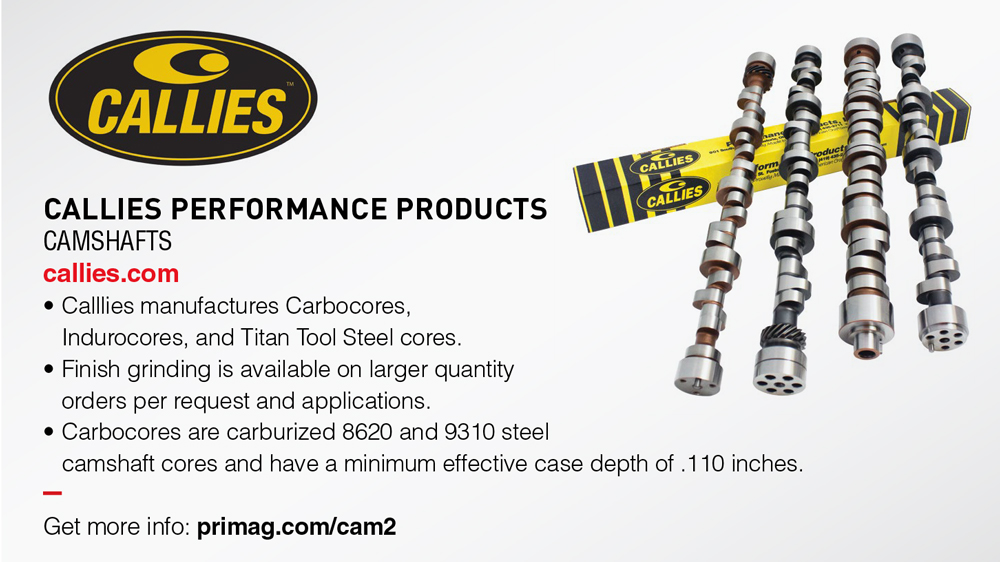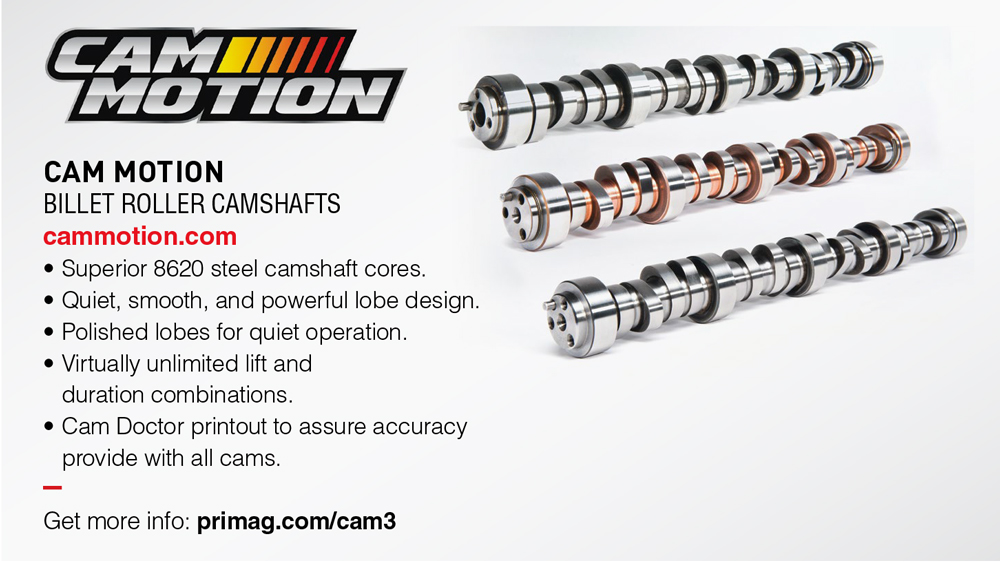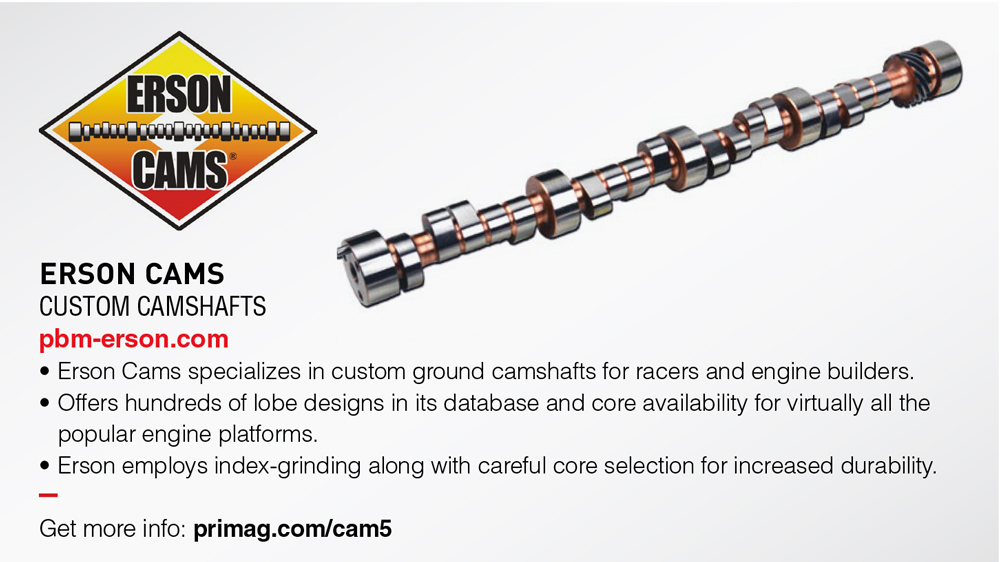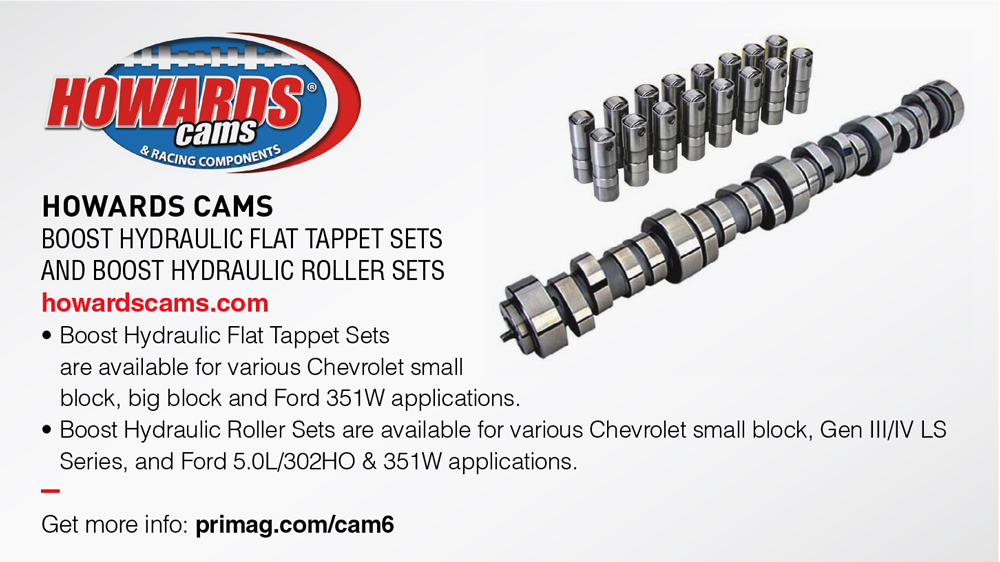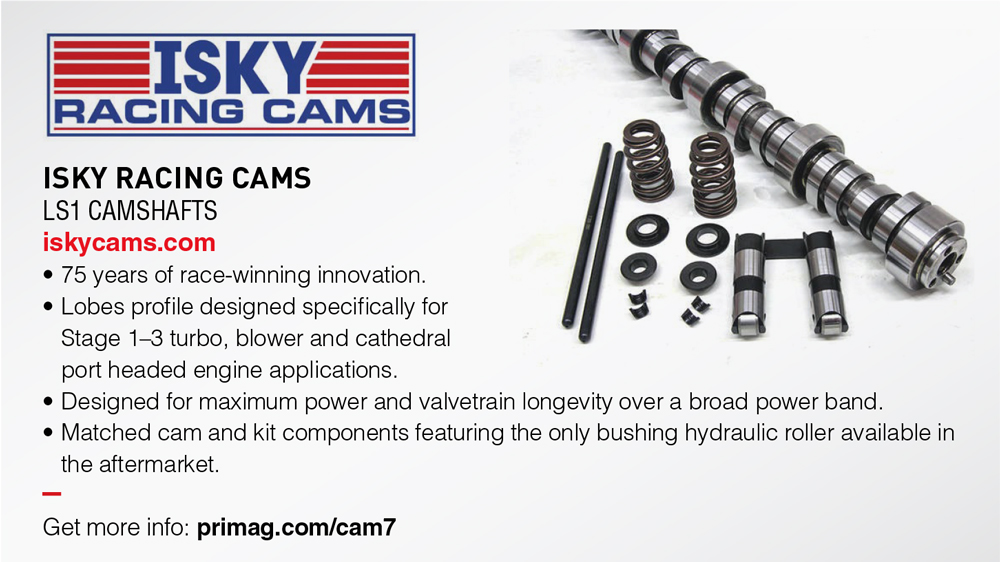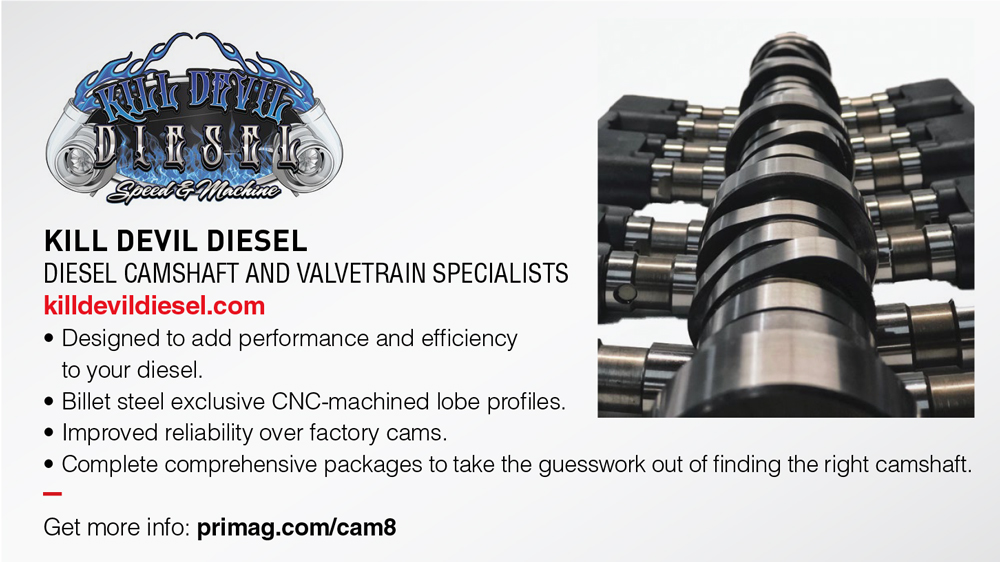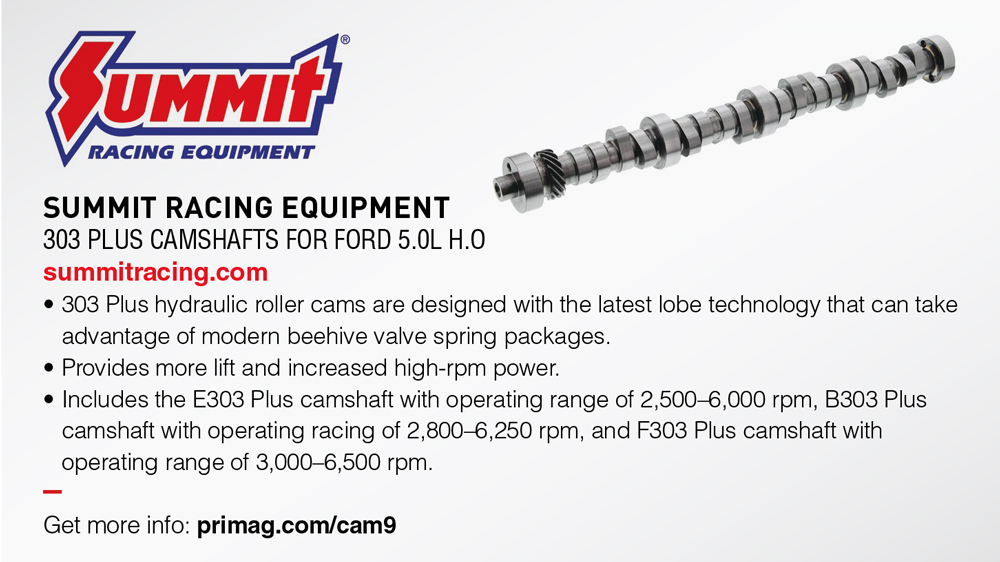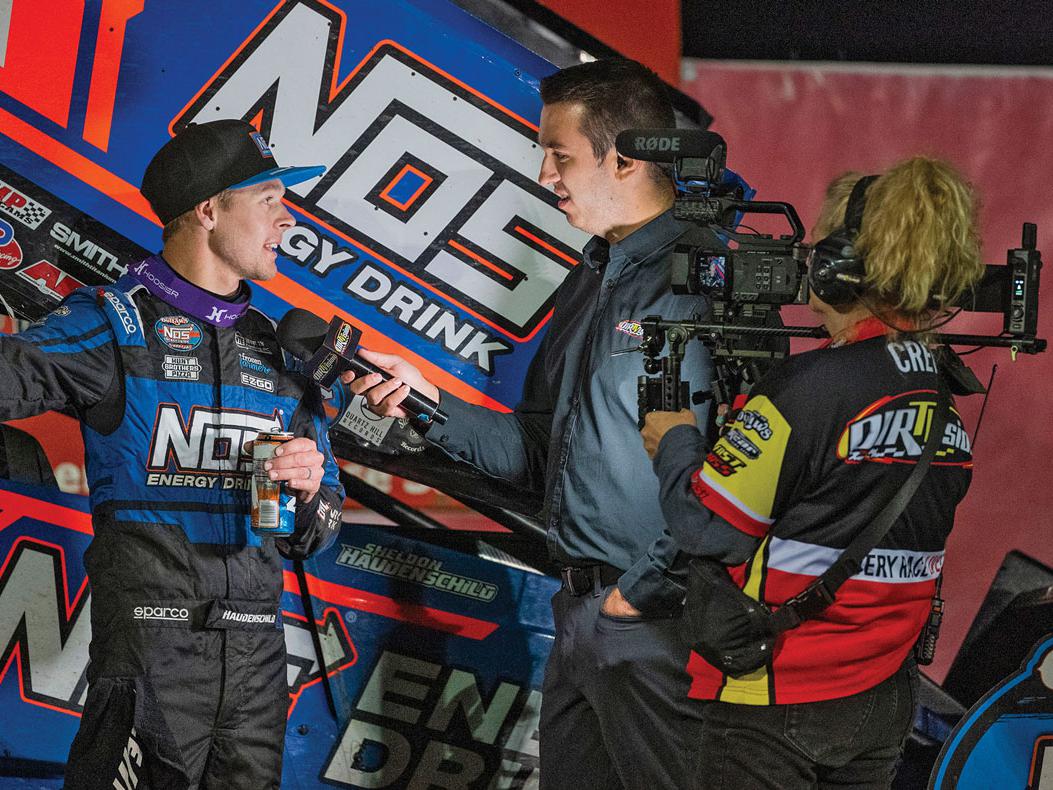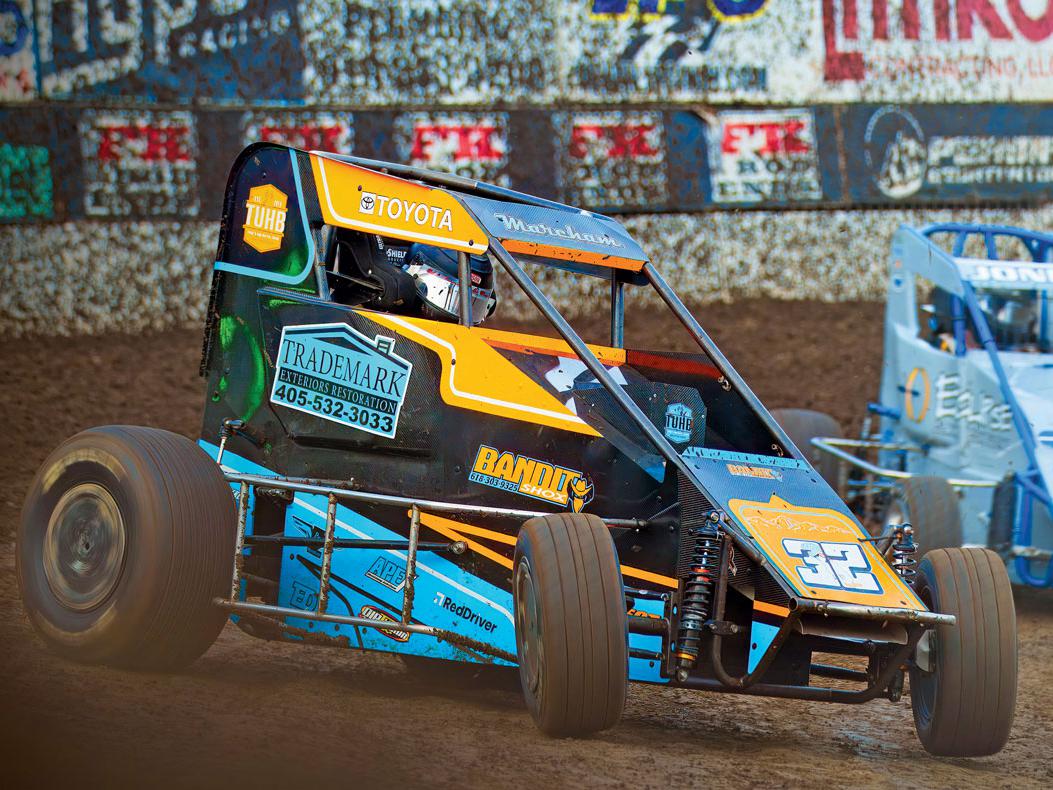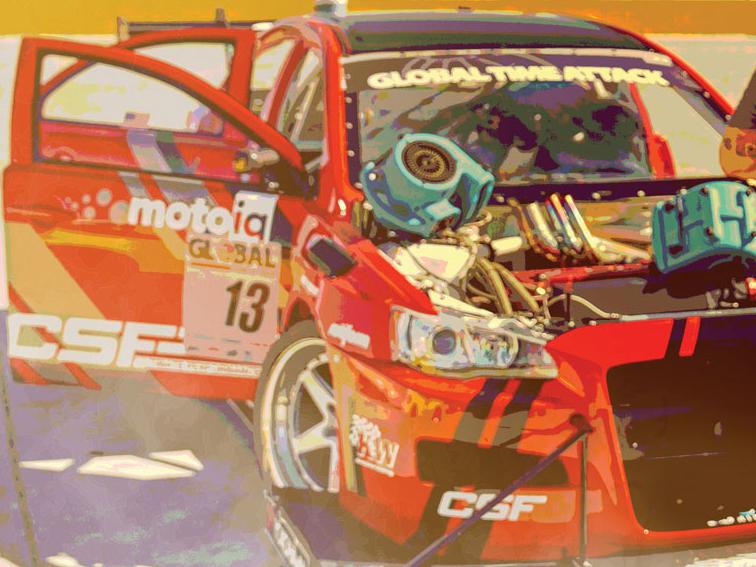ADVENTURES IN CAM DEVELOPMENT
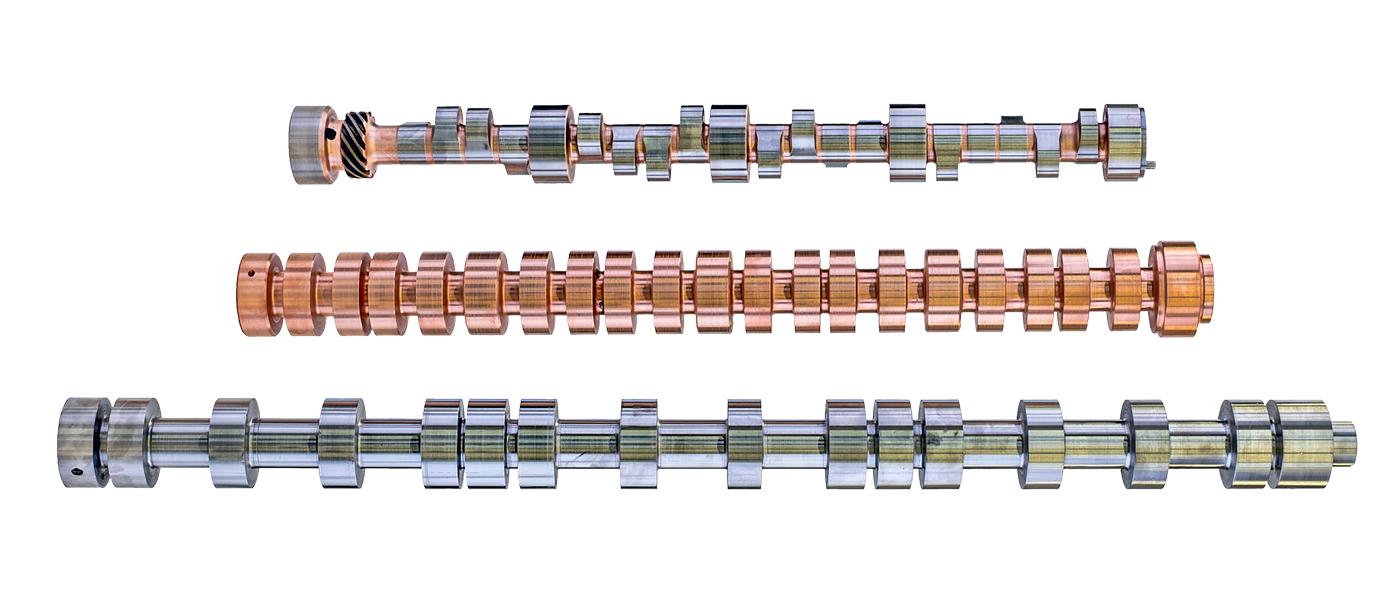
Photo courtesy of Erson Cams
Camshaft grinders are busier than ever, but there’s still time for new ideas and clever tricks.
There’s a talented and winning engine builder in the dirt track and sprint car community who’s always willing to “try something different,” even when the numbers appear dubious. But this flexibility is likely one of the keys to his success.
“This customer did not expect much with the cam change because the specs were too close,” recalled Billy Godbold of COMP Cams, Memphis, Tennessee, adding that he had suggested the engine builder replace a “state-of-the-art” camshaft profile with COMP’s new Low Shock Technology (LST). “The cool part about this case was not what it did on the dyno, but what he saw on the track.”
The race team built two engines to conduct extensive A-B-A testing at the track.
“As we are finding in almost every case with these profiles, the biggest gain was how the reshaped overlap triangle improves transient response, both during high engine acceleration and during rapid throttle changes,” explained Godbold. “By building two identical engines—with the only difference being the new Low Shock lobes on one—both the driver and the stopwatch could clearly tell which cam was on the track. On these short dirt tracks, making a change that the driver feels and the time verifies is a pretty amazing improvement.”
COMP’s Low Shock Technology is a lobe-design strategy that is gentler on the valve spring and thereby reduces unwanted harmonics in the valvetrain. It’s almost the flip side of very aggressive design strategies that have been popular throughout the industry. Yet, this game plan has generated hundreds of new grinds for the COMP brand.
“We started with the new Low Shock profiles in just the professional classes, but today there are full offerings across street performance, street/strip, road race, and circle track, including both flat tappet and roller,” added Godbold. “To give some perspective of just how many new designs we had to make, the drag race list alone is approaching 650-plus lines deep, so there have been literally thousands of new Low Shock Technology profiles added to our lobe library over the past 24 months for everything from as small as a go-kart engine to as large as an industrial diesel engine.”
STAYING BUSY
Despite scattered slowdowns in the racing market, leading cam grinders throughout are showing little work stoppage as customer demand is holding steady, if not increasing.
“We’re absolutely swamped,” said Cale Risinger of Melling Performance, Jackson, Michigan. “It’s a good problem to have.”
“We’re just trying to keep up,” agreed Brook Piper of Callies Performance Products, Fostoria, Ohio.
“We’ve been so covered up with what we’re already doing, we haven’t had a lot of extra time for development,” said Russ Yoder of Erson Cams, Louisville, Kentucky. “It’s a bit of running joke. We’re wondering where all these cams are going because we’ve been busier than normal all summer long,” he added when interviewed last fall.
Most cam companies that deal directly with engine builders and teams have been buoyed by the growth in popularity of certain racing segments. And with every new cylinder head or larger turbo that hits the market to serve those classes, cam grinders digest all that data to suggest a lobe profile that takes advantage of the new hardware.
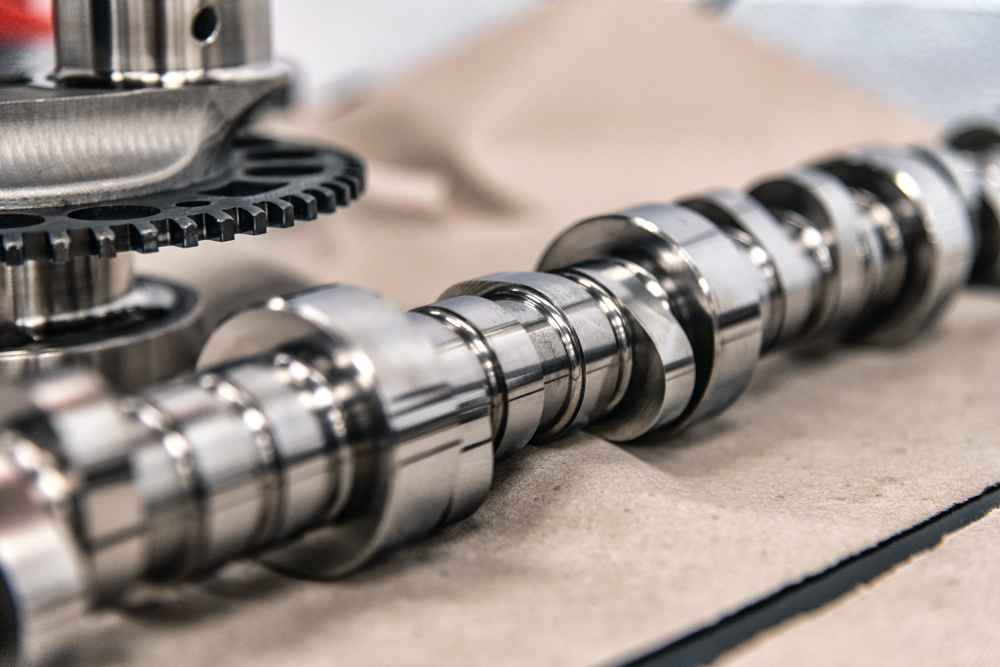
“We’re doing a lot of street outlaw and Pro Mod stuff,” said Nolan Jamora of Isky Racing Cams, Gardena, California. “Definitely you see more R&D and dyno’ing. Guys like Pat Musi and Steve Morris are continuously doing new stuff to keep up front. I mean, in [NASCAR] Cup racing you don’t have engine builders doing their own thing like the old days. You’re definitely seeing more development in drag racing.”
Massive boost is driving the outlaw drag racers these days, and engine builders aren’t afraid of more duration and wider lobe centers.
“Also, looking at the fuel flow and what the droplets are doing,” continued Jamora, “it’s a big difference from what it was before. The engines have to be tunable. It may be 70 degrees when they start racing, and by the time they finish it might be 30 degrees. So, there has to be a wide range of tuning on the cam, especially when using boost. It really helps to have a cam that is good between a wide power range and not just one particular rpm or one particular fuel flow, which it kind of was in the old days.”
One of the cam specs that came up often during discussions with cam grinders across the country was lobe separation. It appears the numbers are getting wider as engine builders look for more finite control of the combustion. Some non-boosted engines are going as wide as 121 degrees, while boosted engines are regularly running 118 degrees.
“That would be the norm now,” said Jamora. “There is nothing lower anymore with all the boost they’re putting in.”
This trend has also prompted serious technical theory discussions among racers and cam grinders.
“Racers, enthusiasts, and even many well-known engine builders have some misconception in regards to the effects of lobe separation angles on a given camshaft’s performance characteristics,” said Steve Balusik of Cam Motion, Baton Rouge, Louisiana. “To clear up these misconceptions, we encourage engine builders to look at ‘valve events’ as their primary consideration instead of lobe separation angles.” (For more detail, see the sidebar below.)
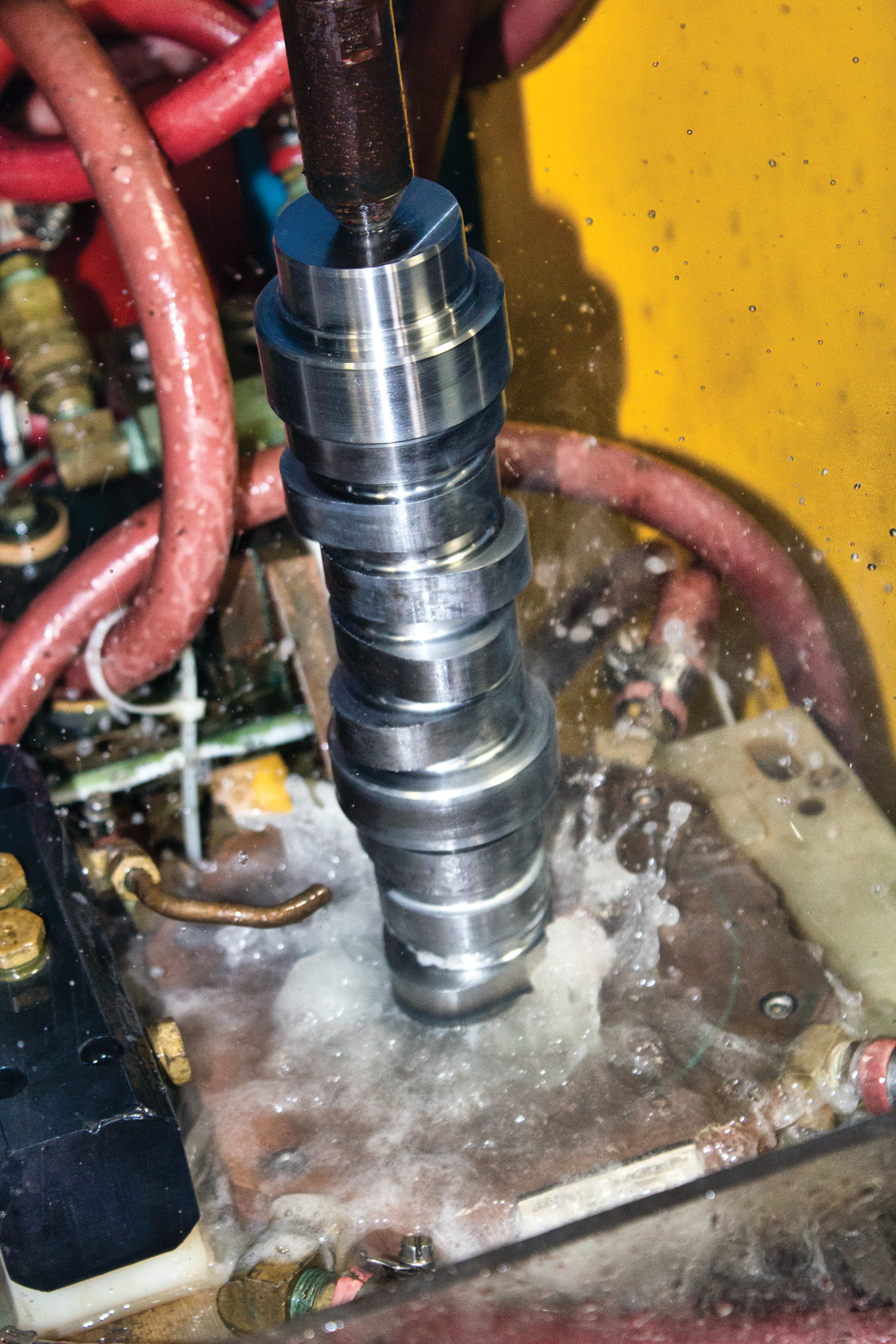
“It’s all about where you open the valve,” confirmed John Partridge of Bullet Racing Cams, Olive Branch, Mississippi. “In a boosted engine, you’ve got to open the valve early enough to get the cylinder filled. You’re trying to stuff 10 pounds into a five-pound bag. You’ve got to get the valve open at the right time to make all that happen. With nitrous, you don’t have to open quite as early. But what’s more critical is the exhaust side. You have to have that pullover effect to keep the thing from burning itself up.”
Over at Callies, the emphasis is on developing cam cores that leading cam grinders purchase for finishing, including massive 70-mm tool steel cores for Pro Mod engines. Also, 11,000-horsepower engines are drawing attention as suppliers help the nitro drag-race teams improve durability.
“We’re doing more Top Fuel cores,” said Piper. “At one time 18 to 20 passes was considered really good for a camshaft. It’s safe to say we’ve doubled the core life in Top Fuel engines. Making them faster, that’s our biggest problem.”
The company has also developed camshafts for the Ford 7.3-liter Godzilla truck engine, and there is growing demand for Powerstroke diesel products, too. Callies recently acquired a Spintron to help advance development projects.
“We’ve got an R&D lab set up and will be doing camshaft testing at our facility,” added Piper. “And we’re working with a Top Fuel team on valvetrain testing.”
Drag racing continues to drive new products at Crower, especially when engineers can take advantage of stronger alloys to keep up with cylinder head development.
“The materials have gotten better. We’re using 8620 steel billet. And the lifters have gotten better,” noted Guy Aguayo of the San Diego, California-based company. “We’re getting up to one-inch lift on sportsman cams these days. There are cylinder heads that flow big numbers, so you work the lift up to where the big numbers are.”
Crower is also seeing growing numbers of Top Sportsman and Top Dragster engines running ProChargers or nitrous, and even the Stock classes are looking for more power.
“We have cams that can help in a certain direction,” said Aguayo, adding that flat-tappet camshafts are still in demand. “There are X amount of flat-tappet cams that we carry. Some have been around for 15 to 20 years and they still work for those applications.”
It’s the same at Erson, where drag racers are calling in search of recommendations. “I’m assuming much of that is tied to the street outlaw trend,” said Yoder. “I guess everyone has been home working on their hot rods and doing projects that they’ve put off.”
Yoder said production has been slowed at times due to a shortage of iron cores sourced in the US. “I understand the problem is getting materials to make the cores,” noted Yoder. “There are only two that make the OE-style cores, and we’re basically buying all we can from either one. With steel cores, there are four or five more vendors to work with.”
Melling recently acquired Performance Springs UK Ltd., a valve-spring company in the United Kingdom, and that move has opened up more possibilities for the cam designers. “It’s got us to look at the cam programs, realizing we don’t have to source springs to do what we want to,” said Risinger, adding that new LS cams designed for street performance are in development. “Also looking at the 4.6-liter Ford. We really need to catch up with the late-model Hemi and Ford modular engines. That’s going to be the focus for us next year, along with the LS.”
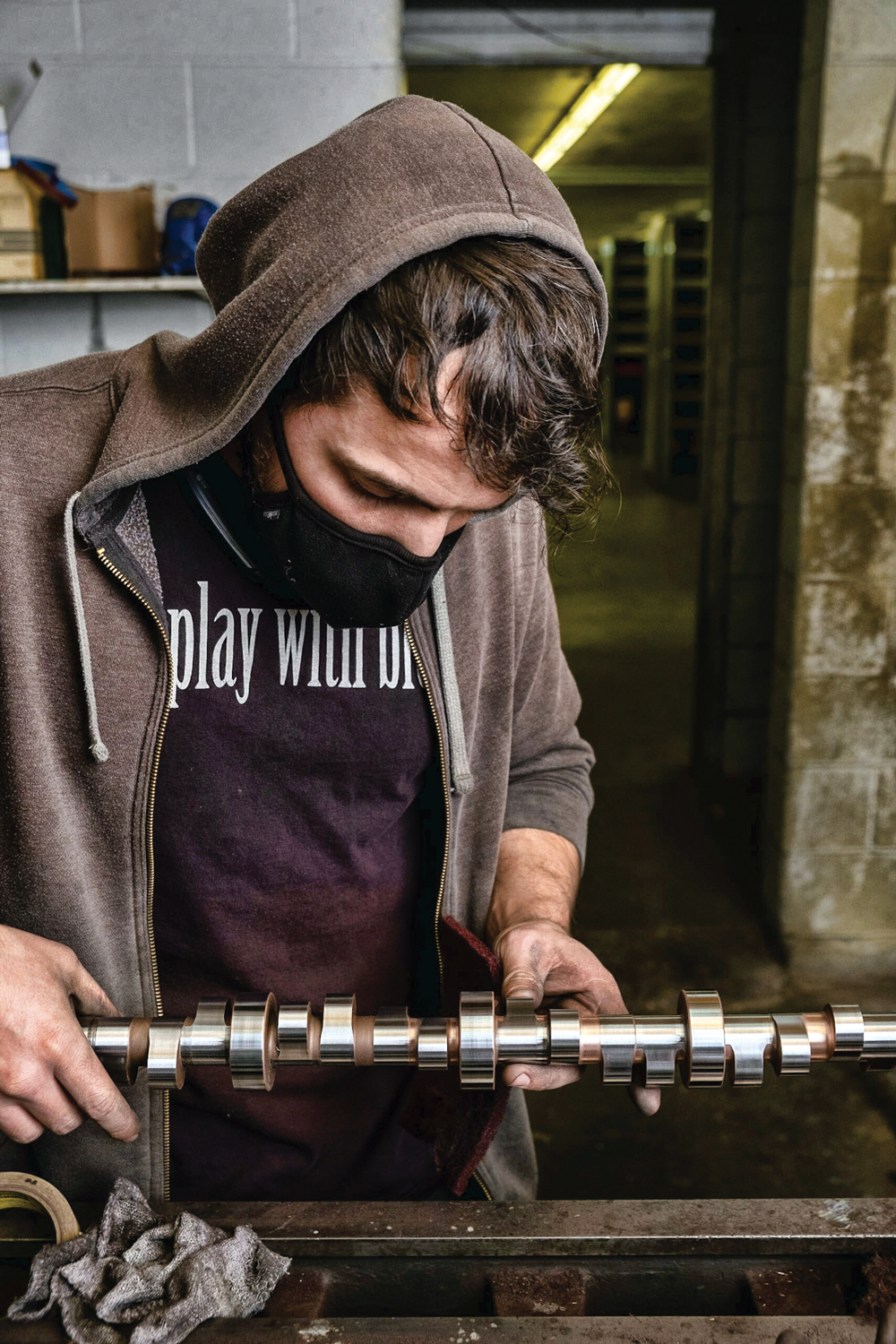
Racers have long looked to camshafts for a competitive edge. Lobe profiles are one of the most closely guarded secrets, although some say it’s very easy to reverse engineer a camshaft. Still, debating camshaft designs and even firing orders—which the cam controls—is one of the more popular exercises at the track or in the garage. When sanctioning bodies try to limit cam development, so-called “cheater cams” start making their way to market.
“We do a lot of cheater stuff,” boasted Partridge. “The reason is, there’s a demand for it. If there’s a class that has XYZ rules, we’re going to push those rules as far as we can. For example, if there’s a .450-inch maximum valve-lift rule, we increase the amount of area across the top of the lobe. Basically, we hold the valve open longer and now the motor thinks it’s got .500-inch lift.”
Perhaps the one engine component that drives camshaft development is the cylinder head, and they can be quirky at times.
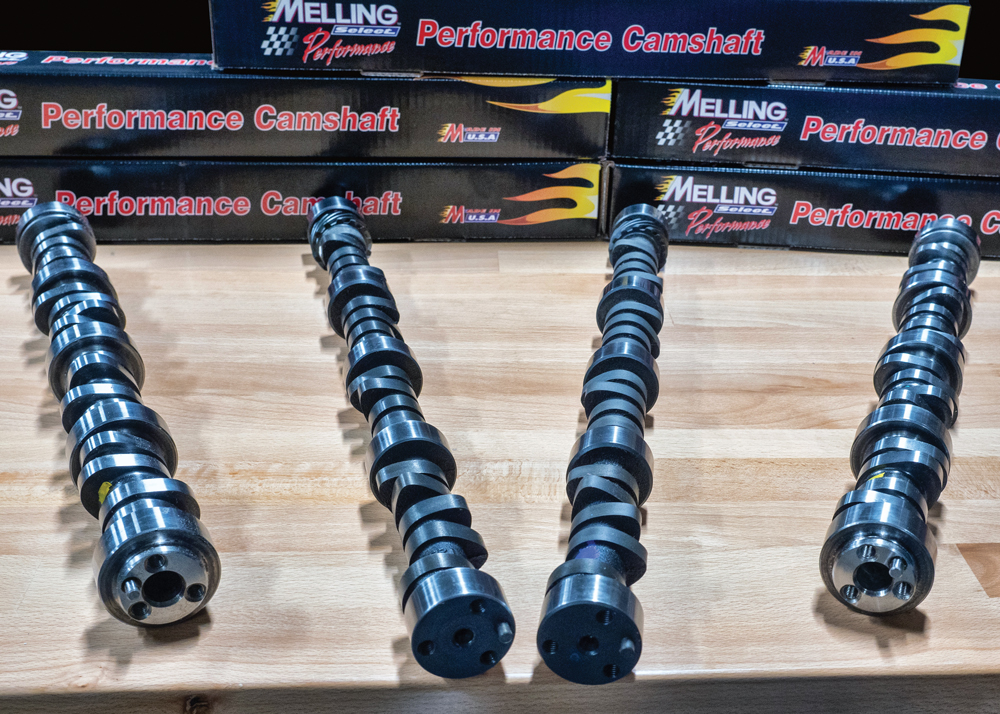
“Understanding the valvetrain ‘system stiffness’ for each new cylinder head and rocker configuration is always a challenge,” said Godbold. “Even with the same head, there can be multiple different rocker systems and valvetrain mass combinations that require quite different approaches. Even with similar engines, you have to understand how the different build and application constraints will change what will be the best camshaft for your unique needs.”
“You definitely see [cylinder head development] in combustion chambers and how they’re directing flow and swirl with changes in the shape. We’re still finding new cylinder heads all the time,” added Jamora. “You definitely have to keep up, and it’s more of a partnership thing now. Before, they would just say this is what I got. Now you’re more involved from the start.”
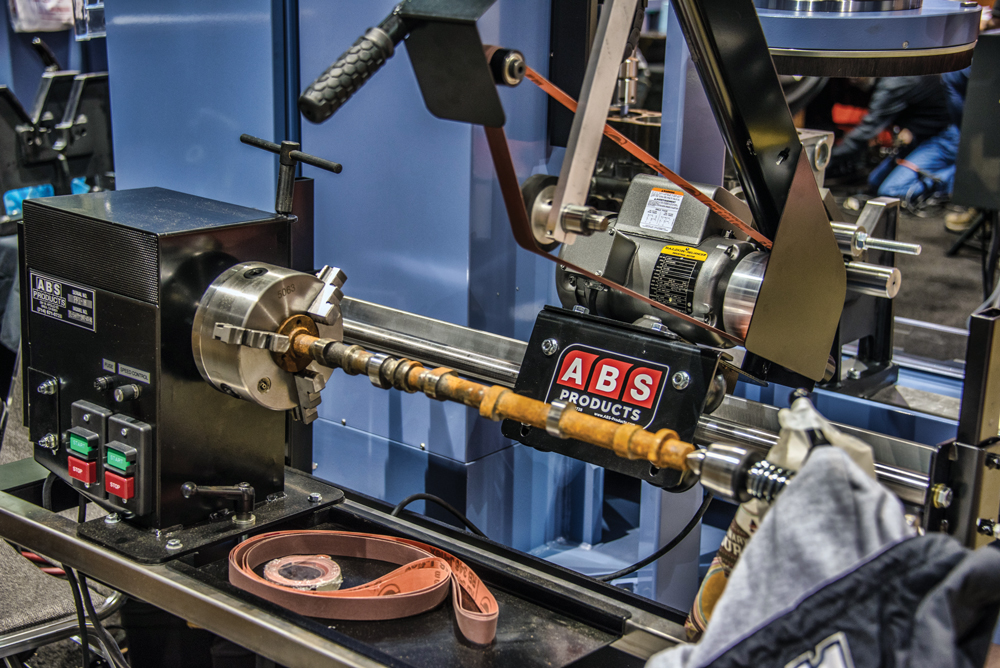
Finally, racers and enthusiasts love to talk about extremes in camshaft development. Think about it: There are now racing camshafts with 80-mm bearing journals. That’s larger than many crankshaft main journals! Advances in lifter design, pushrod stiffness, rocker-arm geometry, and valve-spring strength have certainly allowed cam designers to try more aggressive lobe profiles, and total valve lift is sometimes a bragging point in the pits. Talk of Pro Stock or Pro Mod engines running over 1.3-inch of valve lift is not uncommon.
“Where the valve spring can accommodate the requirement, lift over diameter (L/D) ratios are commonly 45–50 percent for most race camshafts on the intake side, especially those incorporating 50-plus degree seat angles,” said Godbold. “For a 45-degree seat, L/D closer to 40 percent is common. With that in mind, you can quickly see how something rather large that Sonny Leonard would build should be well over 1.3-inch valve lift (0.700-inch or greater lobe lift with 1.9:1 or higher rocker ratio), but a large ship engine we could consult on might be over 2-inch valve lift.”
Sidebar: The Main Event
The term “valve events” as noted by Steven Balusik of Cam Motion, Baton Rouge, Louisiana, refers to the timing of when the intake and exhaust valves open and close as measured in degrees of crankshaft rotation at a certain amount of lobe lift.
In the accompanying illustration, there are three cams—each with 280 degrees intake duration and 290 degrees exhaust duration measured at .050-inch lift at the lifter. The first cam has a 112-degree lobe separation angle (LSA), the second has a 114-degree LSA, and the third has a 116-degree LSA (all are circled in green in the illustration). And all three versions have four degrees of advance ground into camshaft.
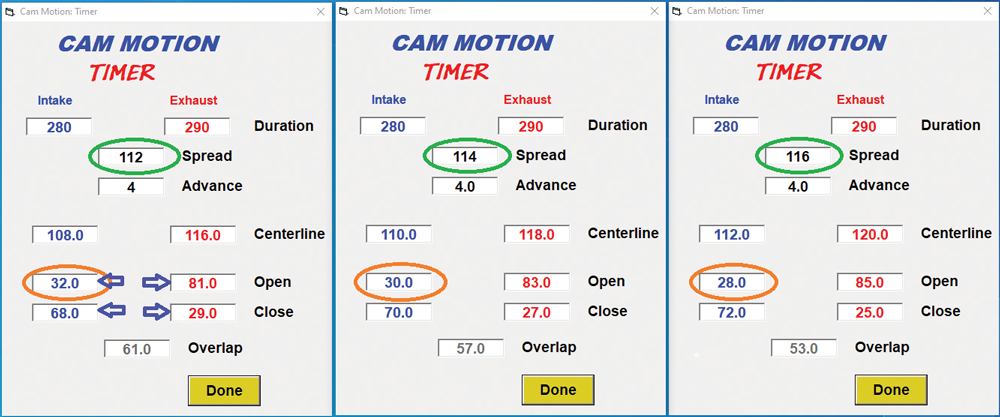
“As mentioned, all three camshafts have the same intake and exhaust duration, yet all three camshaft examples have different valve events—that is, the timing of the opening and closing of the intake and exhaust valves,” explained Balusik. “The only thing that was changed was the lobe separation angle. The point is that when you change the LSA of a given camshaft, you change all four valve events. This is important because all four valve events have their own unique effect on engine performance. As you will likely agree, changing four things at once is not a very concise way to optimize.
“We recommend that you look at each valve event specifically and consider their corresponding effect on engine performance,” he added. “Choose your valve events based on their desired effect on engine performance and let the LSA fall where it may.”
 MEMBERSHIP LOGIN
MEMBERSHIP LOGIN JOIN PRI
JOIN PRI

